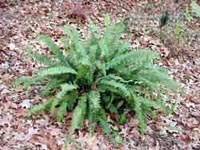Resource Library
Plant of the Week: Sword Fern, Erect
The University of Arkansas System Division of Agriculture does not promote, support or recommend plants featured in "Plant of the Week." Please consult your local Extension office for plants suitable for your region.
Plant of the Week
Erect Sword Fern
Latin: Nephrolepis cordifolia

The difference between an ornamental and a weed is often one of perception. A number of ornamental plants have escaped into the wild in all parts of the country where they out-compete the natives for space at Mother Natures dining room table. One of the plants recently listed as a weed in Florida and placed on the "do not grow" list for the Florida nursery industry is the Boston fern relative, Nephrolepis cordifolia, the Erect Sword Fern.
The Erect Sword Fern is an upright growing fern with fronds that have the feather-like pinnate arrangement of the Boston fern but with a tougher texture. The foliage color is a deep forest green when well grown. Plants can reach 30 inches in height and form dense clumps. In shaded sites the plants will have a more arching habit.
The Erect Sword Fern does not have the wispy runners produced on the Boston fern. Instead it produces an underground rhizome that enlarges the size of the clump. Along the rhizome, and an inch or two below the soil line, are a number of grape size greenish tubers which readily distinguish the Erect Sword Fern from the Boston fern.
The invasive plant issue gained stature in the waning years of the Clinton administration when Vice President Gore convened a panel of experts to come up with recommendations on how to get a handle on the escaped plants problem. While a report was prepared and recommendations made, little has as of yet changed in the way plants are produced and sold in the nursery industry. Eventually each state (perhaps region) will develop a list of potentially invasive plants and then ban production and sale of those potentially invasive plants within the region.
The case of the Erect Sword Fern points out some of the problems in deciding what to consider an invasive plant. Nephrolepis cordifolia is a tropical and subtropical fern with wide natural distribution in warm climates, but apparently not Florida. When it was imported as an ornamental, apparently from Australia, it found a congenial climate in the Sunshine state - just like all of the other human and floral migrants.
Kimberly Queen Fern is a selection of the species that has gained considerable popularity among Florida growers because they discovered it can be grown in full sun as a nursery crop in outdoor growing beds. With lower production costs than ferns requiring either a greenhouse or a shade house for production, its popularity soared. This low cost of production of course made it a favorite of the mass market retailers looking for low price merchandise, so it is shipped nationwide from Florida growers.
The Kimberly Queen Fern is sometimes listed as a selection of N. obliterata - an auspicious name if there ever was one - but most references refer it to N. cordifolia. Kimberly Queen is similar to the species but with a more tidy growth habit.
In Arkansas, and in fact most parts of the country, the Erect Sword Fern and the Kimberly Queen Fern are well-mannered guests in our gardens. Only in the south (zones 9 and 10) does it settle in for a long visit like some unwanted distant relative. Future regulations that aim to restrict the sale and distribution of plants will need to be flexible enough to accommodate these regional differences.
Kimberly Queen Fern is a good pot plant for patio decoration but is too erect growing for use in hanging baskets. But, because it is so fast growing, I like to use it in the garden as a ferny green accent or a backdrop. It can be grown in sun or shade in any average soil with no special attention to water.
I have left the plants in the ground several years here in Fayetteville and they come back from the storage tubers each year, but it is midsummer before they are pushing up enough green to notice. A more successful method of over winter protection I used is to cut the fronds off in the fall, dig the clump with a ball of soil and throw it in a plastic trash bag. Store the bag in a location where it doesn’t freeze during the winter. When the danger of frost is past, plant the clump back out and in no time it will be up and growing.
By: Gerald Klingaman, retired
Extension Horticulturist - Ornamentals
Extension News - June 7, 2002
The University of Arkansas System Division of Agriculture does not maintain lists of retail outlets where these plants can be purchased. Please check your local nursery or other retail outlets to ask about the availability of these plants for your growing area.